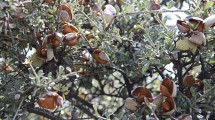Abstract
In almond, gametophytic self-incompatibility is controlled by a single multiallelic locus (S-locus). In styles, the products of S-alleles are ribonucleases, the S-RNases. Cultivated almond in California have four predominant S-alleles (S a, S b, S c, S d). We previously reported the cDNA cloning of three of these alleles, namely S b, S c and S d. In this paper we report the cloning and DNA sequence analysis of the S a allele. The Sa-RNase displays approximately 55% similarity at the amino-acid level with other almond S-RNases (Sb, Sc, and Sd) and this similarity was lower than that observed among the Sb, Sc and Sd-RNases. Using the cDNA sequence, a PCR-based identification system using genomic DNA was developed for each of the S-RNase alleles. Five almond cultivars with known self-incompatibility (SI) geno-types were analyzed. Common sequences among four S-alleles were used to create four primers, which, when used as sets, amplify DNA bands of unique size that corresponded to each of the four almond S-alleles; S a (602 bp), S b (1083 bp), S c (221 bp) and S d (343 bp). All PCR products obtained from genomic DNA isolated from the five almond cultivars were cloned and their DNA sequence obtained. The nucleotide sequence of these genomic DNA fragments matched the corresponding S-allele cDNA sequence in every case. The amplified products obtained for the S a- and S b-alleles were both longer than that expected for the coding region, revealing the presence of an intron of 84 bp in the S a-allele and 556 bp in the S b-allele. Both introns are present within the site of the hypervariable region common in S-RNases from the Rosaceae family and which may be important for S specificity. The exon portions of the genomic DNA sequences were completely consistent with the cDNA sequence of the corresponding S-allele. A useful application of these primers would be to identify the S-genotype of progeny in a breeding program, new varieties in an almond nursery, or new grower selections at the seedling stage.
Similar content being viewed by others
Author information
Authors and Affiliations
Additional information
Received: 21 June 1999 / Accepted: 15 November 1999
Rights and permissions
About this article
Cite this article
Tamura, M., Ushijima, K., Sassa, H. et al. Identification of self-incompatibility genotypes of almond by allele-specific PCR analysis. Theor Appl Genet 101, 344–349 (2000). https://doi.org/10.1007/s001220051489
Issue Date:
DOI: https://doi.org/10.1007/s001220051489




